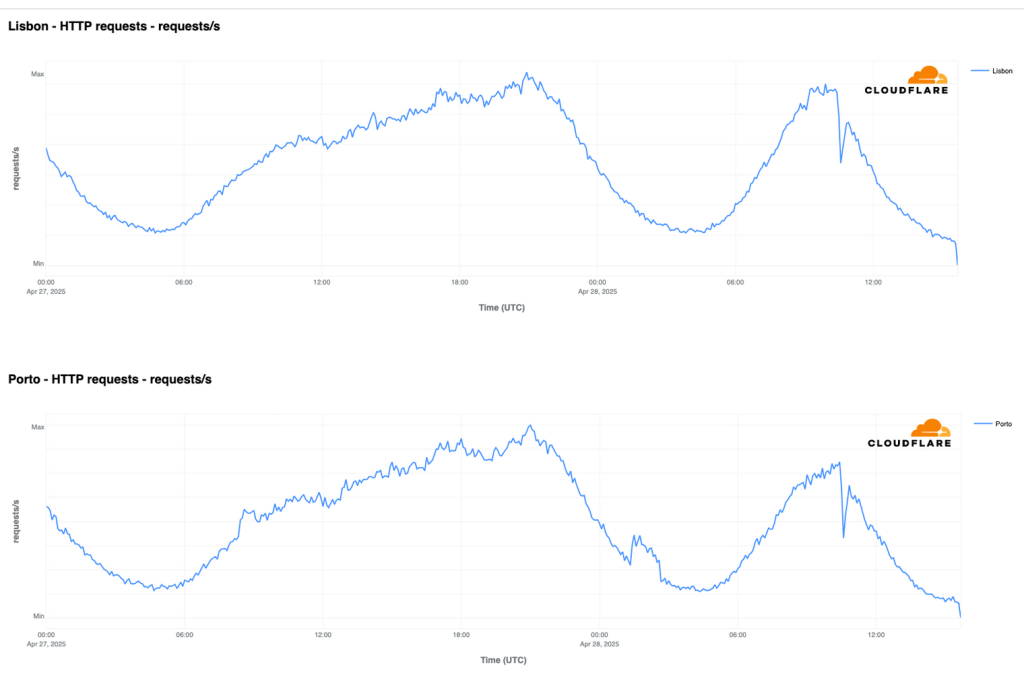- A major power outage in Spain has impacted the country’s and its neighbors’ power and Internet access.
- Understanding electricity resilience and reliability is critical when measuring and developing Internet resilience.
- More open-sourced and standardized data on the Internet and electricity ecosystems can improve decision-makers’ efforts to improve Internet resilience.
Yesterday’s nationwide power outages and subsequent Internet outages in Portugal and Spain are important reminders that electricity is the ultimate limiting factor affecting Internet resilience. If there is no electricity to power routers, switches, receivers, and data centers, then there is no Internet.
An equally critical lesson from these and the 38 other power-related national Internet disruptions that Cloudflare Radar has recorded since 2023 is the increasing importance of understanding and managing the relationship between electricity and Internet resilience.
What Happened in Spain and Portugal
On 28 April, at around 10:30 UTC, Spain’s electricity grid operator, Rede Electrica Nacional (REN), confirmed nationwide power outages that were being reported.
Soon, further reports emerged that these outages affected electricity and Internet services in Andorra, Morocco, Portugal, and Southern France.
Like the Internet, national electricity grids have developed several avenues of redundancy to support national electricity production efforts and alleviate the effects of outages. These include interconnecting with other national grids, developing alternative transmission paths, and collaborating with businesses and communities to establish distributed energy resources like off-grid or backup generation and energy storage systems.
France’s electricity grid operator, Réseau de Transport d’Électricité (RTE), rediverted power from its national grid to affected regions of France, Andorra, and parts of Northern Spain within the hour. Portugal’s grid was not as agile, given that it relies heavily on Spain’s, especially in the morning—because Spain is one hour ahead and electricity produced by its solar plants is cheaper than producing it internally.
According to the International Energy Agency (IEA), Portugal imported around 20% of its electricity needs in 2023, a figure that has been growing steadily since 2016 (Figure 1).

Conversely, Spain has been increasing its net export of electricity (Figure 2).

Internet Connectivity Drops to 10% in Portugal, 20% in Spain
When we examine how Internet connectivity has been affected (and slowly reconnected), we get a sense of Portugal’s (and Morocco’s) reliance on Spain’s electricity and Internet infrastructure.
Cloudflare is one of the largest Content Distribution Networks in the world, with data centers in 335 cities, including Casablanca, Barcelona, Lisbon, and Madrid. To give an example of Cloudflare’s importance in the Internet landscape, Internet users in Morocco, Portugal, and Spain access between 29% and 43% of the top 1,000 most popular web content via Cloudflare data centers (Search the interactive below).
Given this unique position, Pulse often refers to Cloudflare data when assessing the impact of deliberate Internet disruptions or outages. Figures 1 and 2 show the significant drop in Internet traffic to Cloudflare resources at around 10:30 UTC compared to traffic from the week before and the gradual increase in traffic across the following 12 hours.


Pulse data partner IODA also recorded similar trends for Spain and Portugal.
Cloudflare noted in its analysis of the outages that traffic disruptions varied in different regions of all countries affected by the power outage based on ongoing power restoration efforts. Interestingly, they showed how traffic bounced back quickly in Lisbon and Porto, only to fall away again (Figure 5).

It’s hard to tell precisely what the reason for this is, but it could relate to networks redirecting traffic to Cloudflare only for those networks, Cloudflare’s infrastructure, or the Internet users to lose power.
The latter is most likely, as most Internet Service Providers and data centers have backup generators.
In Morocco, Orange Marocco posted on X that the power outages had affected international connections between Morocco, Spain, and Portugal.

Significantly, 90% of the top 1,000 web services accessed by Morocco’s Internet users are hosted in Spain (Search the interactive below).
Power and Internet Resilience Go Hand-In-Hand
These exceptional events bring to the fore the Internet’s interconnectivity and its various components’ resilience at a country and regional level. A resilient Internet connection maintains an acceptable level of service in the face of faults and challenges to normal operation.
As of 2023, Spain and Portugal rank among the top 25 most resilient countries globally (See interactive).
While Pulse recognizes that electricity is one of, if not the most critical component of Internet resilience, we don’t currently include related data in the Pulse Internet Resilience Index due to a lack of global, up-to-date open-source data.
As I noted at APRICOT 2025, this data will become increasingly important for countries that also aim to become regional data centers and AI hubs. Without up-to-date and standardized data, it will be difficult for decision-makers in these countries to forecast the impact of this energy-intensive infrastructure.
We will continue to track this and other power-related Internet issues and advocate for decision-makers to consider these as part of their Internet resilience-related policies and projects.
Photo by Tawseem Hakak on Unsplash


